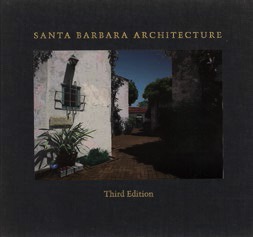
SANTA BARBARA ARCHITECTURE
Photography by Wayne McCall
Text by Herb Andree & Noel Young
Introduction by David Gebhard
First Edition December 1975
Second Edition September 1980
Edited and designed by Bob Easton & Wayne McCall
Third Edition available fall 1995
By the early 1890s Santa Barbara had established its preeminence as a place to live and as a place to winter. The 1893 Baedekers referred to the city as the “American Mentone” and went on to note “It has a well-deserved reputation as one of the most attractive winter resorts in California, due to its mild, dry and equable climate, the beauty of its surroundings, the luxuriance of its roses and other flowers, the excellent bathing beach, and its pleasant society.” Santa Barbara enjoyed an equally impressive reputation during the early decades of the nineteenth century when, along with Monterey to the north, it was the most important of the Spanish and later Mexican bastions in California.
A mild climate, and a superb setting, are impressive assets for any place-but these qualities account only in part for the positive aura that the name Santa Barbara has continued to evoke for well over a hundred years. The other ingredient revolves around what man has or has not done to a specific physical environment. The really unique aspect of Santa Barbara and its environs is that man’s manipulation of this place has (on the whole) enhanced rather than devastated it-and this has been true from the very beginning.
Table of Contents
- Spanish Colonial and Mexican Period
- Victorian Architecture
- Revivalism, The Post Victorian Era
- American Colonial
- Mission Revival
- Medieval
- Mediterranean/Classical
- The Craftsman Movement
- Spanish Colonial Revival
- Period Buildings of the 1920s and 1930s
- Modern
- Architect Biographies